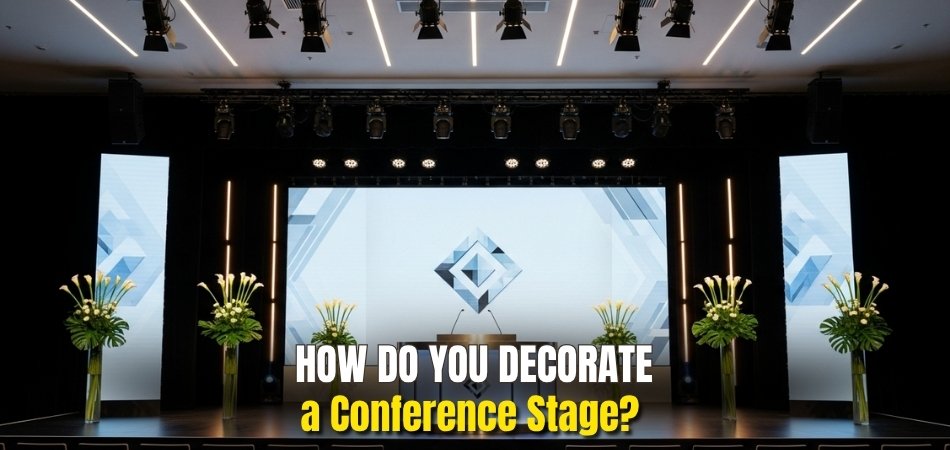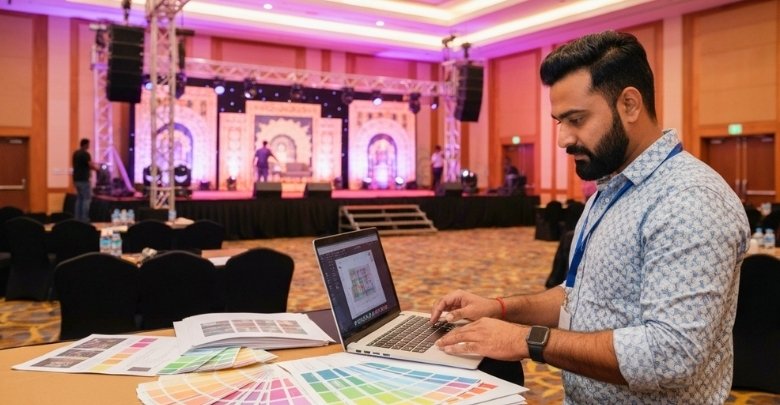A conference stage is the heart of any event. It’s the place where speakers share ideas and the audience stays focused. A stage that looks good can make people feel excited, while a messy one can cause distractions. Simple, smart design makes all the difference.
So, if you are wondering how do you decorate a conference stage, it is not as hard as you might lead to believe.
To decorate a conference stage, plan for the space for speakers and equipment. Use good lighting and sound systems. Add screens for slides or videos. Pick colors that match the event theme. Include logos, banners, or backdrops. Keep the design clean so the stage looks nice but not too busy.
In the rest of this article, we’ll share easy steps to make your stage both useful and attractive.
How Do You Decorate a Conference Stage?
Decorating a conference stage requires careful planning and creative choices to balance style with purpose. The stage is the main focus of any event and sets the overall mood. A well-designed setup helps speakers connect better and leaves audiences with a strong impression. Here are the steps to decorate yoru conference storage.

1. Plan the Layout
- Organize the stage area around the number of speakers, seating arrangements, and equipment placement for better clarity.
- Clear sightlines must guide the audience’s view, while walkways keep movement smooth and prevent unnecessary interruptions.
- Choosing the correct stage size ensures comfort for participants while making the entire area feel professional and organized.
- Focus on pathways that allow staff to move efficiently while minimizing any distractions during key conference moments.
2. Use Effective Lighting
- Proper stage lights highlight speakers and create a bright environment where audiences can stay attentive and engaged.
- Spotlights sharpen focus on individuals, while ambient lighting softens edges and improves the overall viewing atmosphere.
- Color lighting techniques can change moods instantly, adding excitement to product launches or keeping conferences formal.
- Adjustable systems help organizers quickly shift brightness, allowing flexibility for various presentations and entertainment needs.
3. Install Strong Audio-Visual Equipment
- High-quality microphones prevent unclear sound, ensuring that every participant hears discussions without unnecessary effort.
- Large display screens or projectors showcase slides, videos, and infographics, creating more memorable learning experiences.
- Reliable speakers distribute audio evenly throughout the venue, preventing issues that might frustrate attendees.
- Technical checks before the event confirm smooth performance and stop any sudden breakdowns during important sessions.
4. Match Colors and Branding
- Pick colors connected to the event theme, reinforcing emotional tones while creating consistent visual appeal.
- Place logos strategically, reminding attendees of the conference brand without cluttering the overall stage environment.
- Event banners or backdrops build recognition while also offering photo-friendly areas for social media engagement.
- Harmonized color schemes avoid chaos, ensuring that the stage design feels clean, appealing, and cohesive.
5. Add Decorative Elements
- Backdrops and banners enhance depth, creating striking visuals that strengthen the professionalism of the stage design.
- LED walls or projection screens make presentations dynamic while encouraging audience members to stay engaged.
- Thematic installations introduce creativity, turning an ordinary platform into a memorable and immersive conference experience.
- Decorative touches create photo-worthy scenes that boost the online visibility of the event through social media.
6. Set a Stage Theme
- Minimalist setups work well for academic meetings, keeping focus sharp and avoiding unnecessary distractions.
- Bold themes fit product launches, providing strong impressions that match marketing goals and creative energy.
- Designs must align with cultural or professional settings, reflecting the expectations of international participants.
- Countries like Canada, Germany, and Singapore host large conferences; for instance, many conferences in Canada feature thematic stages.
Common Mistakes to Avoid in Conference Stage Design
Designing a conference stage takes more than decoration—it takes smart choices. Small mistakes can ruin the look and feel fast. Good planning avoids these issues and keeps the setup smooth. Let’s look at the common things people often get wrong during stage design.
- Cluttered Layout: Too much furniture or gear on stage limits space for speakers and distracts the audience from key visuals. Clear, open areas help presenters move better and keep the room feeling calm and focused.
- Poor Lighting: Bad lighting causes shadows on faces or makes speakers hard to see, hurting audience focus during talks or panels. Use balanced, bright lights to help everyone stay alert and engaged throughout the session.
- Weak Sound Setup: Low-quality microphones or uneven speaker sound make it hard for people in the back to hear key points clearly. Invest in audio tools that offer clean, loud, and balanced sound from every corner of the room.
- Overused Colors: Bright colors everywhere make the stage look messy and distract from the speaker’s message or the content being shown. Stick with calm, event-matching tones that highlight key areas instead of competing for attention.
- Missing Branding: If logos or brand visuals are missing, the stage feels plain and doesn’t reflect the identity of the event well. Add simple, visible branding to reinforce your message and keep the event looking polished.
- Unclear Sightlines: Placing tall objects or displays in front of seats blocks audience views and leads to frustration during important talks. Always test the view from every angle to make sure all eyes stay on the stage.
- Last-Minute Changes: Quick setup changes on the event day lead to mistakes, missed cues, and wasted time fixing preventable problems. Finalize your design early and leave room for smooth adjustments only if absolutely needed.
- Ignoring Theme: Using random decorations that don’t match the event’s mood breaks the design flow and confuses the audience experience. Always align colors, props, and lighting with the event’s purpose and tone for full impact.
What Makes a Conference Stage Stand Out?
Every big event feels different, and one major reason is the way the stage looks and feels overall. The stage sets the first impression for everyone, from speakers to the entire audience, and it always matters. A creative design makes people pay attention, stay focused, and remember the event clearly. Here is what makes the stage stand out.
Smart Layout
A stage must have enough space so that speakers can move without looking uncomfortable or crowded. The design should make sure equipment does not block the audience’s view or cause confusion. Chairs, tables, or props must be arranged in a way that feels neat and balanced. With the right layout, everything feels smooth and organized.
Bright Lighting
Lighting makes the stage lively, and it also helps people see the speakers clearly. Spotlights can focus on individuals while softer lights cover the background. If lighting is too dull, the event feels boring, and people lose attention. Good lighting creates energy and sets the right mood for the occasion.
Clear Sound
Without clear sound, even the best talk becomes hard to follow. Microphones and speakers must deliver strong, steady audio throughout the venue. If sound drops or cracks, the audience will feel frustrated and distracted. A good sound system makes sure every word reaches everyone with clarity.
Strong Visuals
Large screens or projectors make it easier for people to follow slides, videos, or key points. When visuals are sharp, the audience stays connected and understands more. Blurry or small displays make people lose interest quickly. Visuals done right keep learning fun and engaging.
Color and Theme
Colors change how a stage feels, whether serious, fun, or creative. Matching colors with the event theme makes the stage more meaningful. Random color choices can make the stage look messy and unprofessional. Consistent themes tie everything together and give the event a polished look.
Backdrops and Banners
Backdrops add depth and create a strong focus point for everyone watching. Simple banners or branded visuals remind people of the event identity. Organizers often follow standard backdrop dimensions for conferences to make sure everything fits perfectly on stage. Backdrops also give audiences photo spots that look great on social media.
Creative Touches
Unique props or designs can make a stage unforgettable without going overboard. Something as simple as patterned flooring or digital displays can add flair. However, too many decorations can become distracting rather than impressive. Creative touches should highlight the event, not hide the message.
Key Elements of Effective Stage Decoration
Good stage decoration makes events more exciting and helps audiences stay focused. Every detail, from lights to backdrops, matters a lot. A well-decorated stage sets the mood and makes the event more enjoyable for everyone present. Look at the key elements of effective stage decoration.
Layout and Space
- Enough stage space allows speakers to move freely while keeping equipment positioned neatly for clear and smooth presentations.
- Walkways designed properly give staff and performers simple access while avoiding crowding that causes confusion or unnecessary distraction.
Lighting Design
- Strong lighting helps highlight important people on stage, while softer lights create atmosphere and keep the room comfortable.
- Colors and brightness add mood, giving events energy during performances and keeping audiences alert during long speeches.
Audio and Visuals
- Microphones, speakers, and display screens bring clarity, letting audiences follow both spoken words and visual content with ease.
- Technical checks done before the event keep audio systems reliable and screens functional without disturbing ongoing presentations.
Branding and Colors
- Logos and banners reinforce the event identity, reminding audiences who organized the program without overwhelming the main focus.
- A consistent color scheme creates harmony, avoiding confusion and supporting the theme in every visible stage element.
Decorative Elements
- Banners, backdrops, or LED panels improve visuals, making the stage attractive and keeping attention focused during talks.
- Creative details like props or thematic items add uniqueness while making photographs and videos more shareable online.
Stage Theme
- Minimalist setups fit serious events, while bold designs create excitement for product launches or entertainment-driven conferences.
- Matching the theme with the event goals ensures consistency, making the stage look intentional and not random.
How to Choose Colors and Themes for the Stage?
Every stage has a story to tell, and the colors and themes play a huge part in that. The right choices make the event feel exciting, welcoming, or even formal when needed. A stage without thoughtful design often feels empty or dull. Picking wisely ensures the audience remembers the event for its look as much as its message. Here is how to choose.
Event Purpose
The purpose of the event always guides the stage design. Serious conferences often use calm shades to keep attention on the content. Fun events like festivals or product launches allow brighter colors that reflect energy and excitement. Knowing the purpose first makes every design decision much easier.
Audience Type
Who attends the event should shape the stage colors and style. A younger audience may enjoy bold tones and vibrant themes. Professional groups often prefer subtle shades that feel clean and modern. Choosing with the audience in mind keeps the stage appealing to everyone watching.
Brand Connection
Colors connected to the brand help the event feel authentic. Matching the logo colors with backdrops or banners makes everything look consistent. Overdoing it can feel forced, so balance is always important. A subtle touch of branding can be enough to remind people who is behind the event.
Mood Setting
Colors bring out emotions, and themes help set the mood. Warm shades create energy and excitement during dynamic sessions. Cool tones help audiences feel calm and focused in formal discussions. The balance between these two choices decides the atmosphere of the whole event.
Stage Elements
Every piece of the stage design must support the theme. Props, banners, and even light effects should all connect to the chosen style. Ignoring small details often breaks the flow of the entire design. Attention to these aspects is a key element of conference staging that people often overlook.
Cultural Fit
Colors can have different meanings depending on culture. Red may symbolize celebration in one place but signal warning in another. Themes also need to respect traditions when events host international guests. Careful research avoids misunderstandings and creates a welcoming environment for everyone.
Balance and Simplicity
Too many colors or flashy themes can distract the audience from the actual event. A simple design often works better than an overloaded one. Mixing just two or three colors makes the stage look neat and organized. Keeping things simple ensures the focus always stays on the speakers.
Frequently Asked Questions About Decorating a Conference Stage
A well-decorated stage makes a conference feel professional, engaging, and memorable. Many people often wonder about the details beyond colors, lights, and layouts. Here are some frequently asked questions with clear answers to help you plan a perfect stage.
How Do You Choose The Right Stage Size?
The stage size depends on the number of speakers, the audience, and the event type. Too small feels crowded, while too large feels empty. Measure the venue carefully and balance comfort, visibility, and practical use for the best fit.
What Role Does Furniture Play In Stage Decoration?
Furniture adds function and style to the stage. Comfortable chairs, podiums, or tables must fit the event tone. Avoid oversized pieces that block visibility or cause clutter. Sleek, practical furniture makes the stage look neat and professional without distractions.
Should You Use Plants Or Greenery On Stage?
Plants can soften the stage and bring natural charm to the environment. They add freshness, warmth, and color without overwhelming. Placement matters; greenery should frame the stage, not cover speakers. Simple arrangements work best for formal or casual conference settings.
How Can Technology Improve Stage Decoration?
Modern technology boosts both appearance and engagement. LED panels, projection mapping, or interactive displays create dynamic backgrounds. Carefully used tech highlights key messages without distracting audiences. Balance is important—technology should complement the theme and design instead of overpowering the stage visuals.
What Are Creative Backdrop Ideas?
Backdrops bring depth and act as a visual anchor. They can include fabric drapes, modular panels, or digital screens. Design should reflect the conference theme and brand. Backdrops also create photo-friendly spaces that encourage social sharing and extend event reach.
How Do You Decorate For Hybrid Conferences?
Hybrid events require decoration that works both live and online. Backgrounds should look clean on camera and in person. Avoid clutter that confuses remote viewers. Add branding elements and lighting that translate well across screens, ensuring equal engagement for both audiences.
Why Are Stage Pathways Important?
Pathways help speakers and staff move freely without blocking sightlines. Clear routes reduce accidents and keep the event organized. Decorations should never obstruct these areas. Well-marked pathways also support accessibility, ensuring every participant can move safely and comfortably throughout the event.
Can Seasonal Themes Be Used For Decoration?
Yes, seasonal themes add charm when matched with event goals. For example, winter tones create elegance, while summer shades bring vibrance. Decorations should still highlight the brand identity. Seasonal touches must enhance the mood rather than dominate the stage design.
Final Thoughts
A good stage makes the whole conference feel better and keeps the audience focused on the speakers. Lights, screens, colors, and simple layouts all help create a clear and exciting setup. The question of how do you decorate a conference stage is answered best by planning carefully and keeping designs simple.
Avoid messy looks, pick the right colors, and add small creative details that fit the event. When everything works together, the stage feels welcoming, professional, and easy to enjoy. A well-decorated stage makes the event memorable for everyone long after it has finished.







